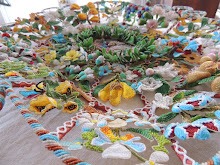 I love this hood. I have had it for quiet some time and always have wondered who wore it, and when. It is in almost perfect condition, and expertly hand made of silk, so most definitely was donned for some special occasion, then carefully packed away. Below is a line drawing, taken from an extant garment, 1702, and is called a 'Camlet Hood'. I am amazed in the fact that it looks so much like the one I have here at the Museum. I have scoured and scoured all my resources, and can find no plain explanation of them. From its construction it is obvious they were either worn during the front half, or the very last, of the 18th century, when hair was worn close to the head. But then again, poorer folk and lesser classes would have always worn their hair close to the head, so they may have been common the century thru. My example belonged to a wealthy ladye indeed, from make and materials
I love this hood. I have had it for quiet some time and always have wondered who wore it, and when. It is in almost perfect condition, and expertly hand made of silk, so most definitely was donned for some special occasion, then carefully packed away. Below is a line drawing, taken from an extant garment, 1702, and is called a 'Camlet Hood'. I am amazed in the fact that it looks so much like the one I have here at the Museum. I have scoured and scoured all my resources, and can find no plain explanation of them. From its construction it is obvious they were either worn during the front half, or the very last, of the 18th century, when hair was worn close to the head. But then again, poorer folk and lesser classes would have always worn their hair close to the head, so they may have been common the century thru. My example belonged to a wealthy ladye indeed, from make and materials The way the bonnet is gathered at the crown of the head, in the back , is a common trait of many 18th century hoods and bonnets attached to cloaks & mantels. The most intriguing aspect for me, are the long lapets down the front. This hood is made of a mushroom brown lightweight silk on the outside, with matching chin ties that are now torn off short, but still original. The inside is lined with a luscious raspberry pink silk, with the area from the chin ties out to the front edge being finely hand quilted in pink silk thread. The seams up the back & over the shoulder are piped in pink silk, with matching silk covered wood buttons.
The way the bonnet is gathered at the crown of the head, in the back , is a common trait of many 18th century hoods and bonnets attached to cloaks & mantels. The most intriguing aspect for me, are the long lapets down the front. This hood is made of a mushroom brown lightweight silk on the outside, with matching chin ties that are now torn off short, but still original. The inside is lined with a luscious raspberry pink silk, with the area from the chin ties out to the front edge being finely hand quilted in pink silk thread. The seams up the back & over the shoulder are piped in pink silk, with matching silk covered wood buttons.
 It measures a whopping 46" around the face!
It measures a whopping 46" around the face!
Inside hand quilted silk lining, you can see the miniscule piped front edge there to the left in the photograph
 The condition is nearly pristine, with slight water stain to the crown, and a nickle sized area of wear to the lining of the right lapet. The fact that there are no fold marks in the silk, makes me wonder if it was worn with the sides folded back, or kept forward. The illustration shows one similar being worn with the lapets folded back, and I have a feeling this one was probably worn the same way, especially with the matching piping on the outer seams. The fact there are no creases in the silk, are more likely attesting to the fact it was worn for a special occasion and then packed away.
The condition is nearly pristine, with slight water stain to the crown, and a nickle sized area of wear to the lining of the right lapet. The fact that there are no fold marks in the silk, makes me wonder if it was worn with the sides folded back, or kept forward. The illustration shows one similar being worn with the lapets folded back, and I have a feeling this one was probably worn the same way, especially with the matching piping on the outer seams. The fact there are no creases in the silk, are more likely attesting to the fact it was worn for a special occasion and then packed away.
The outer silk, while extremely fine and an expensive textile in its day, is still pieced together to make use of every little scrap. This side lapet is 3 separate pieces of silk seamed horizontally.

Closer view of the over the shoulder seams & button trim
 I believe the term 'camlet hood' to be descriptive of the type fabric used, and not the actual 'type' of hood. Camlet was a fabric originally of camel hair, worsted with wool or silk in the 17th century. As I understand, towards the end of the 17th century, goats hair became more common, and have read many 18th century advertisements for super fine silk camlets. There are several 18th century estate inventories listing hoods and bonnets of red and black camlet, and is also sometimes spelled camblet.
I believe the term 'camlet hood' to be descriptive of the type fabric used, and not the actual 'type' of hood. Camlet was a fabric originally of camel hair, worsted with wool or silk in the 17th century. As I understand, towards the end of the 17th century, goats hair became more common, and have read many 18th century advertisements for super fine silk camlets. There are several 18th century estate inventories listing hoods and bonnets of red and black camlet, and is also sometimes spelled camblet. Without actually getting into the time machine I am still waiting to be invented, this bit of history will remain a mystery to me!






















2 comments:
Well, that is one marvelous piece of head ware! Sometimes I think it would be nice for all of us to be able to wear this sort of thing without looking weird in this 21st century. A face peeping out of covering is very pretty and mysterious. Perhaps the movie industry of costumers might have a go at knowing its origins.
Christine
Hello!
Thanks for your visit oh, so long ago! What a wonderful place you have here...I have quite enjoyed myself wandering about..I love all of your fashion and history tidbits..just the kind of place I love to visit.
Thanks so much! N
Post a Comment